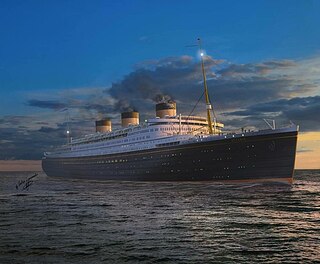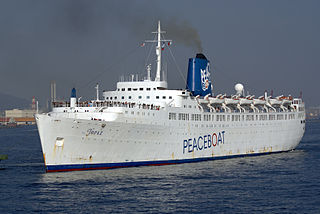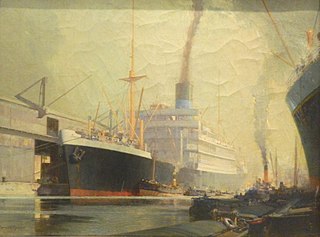
Strategic sealift ships are part of the United States Military Sealift Command's (MSC) prepositioning program. There are currently 49 ships in the program, strategically positioned around the world to support the Army, Navy, Air Force, Marine Corps and Defense Logistics Agency. Most are named after Medal of Honor recipients from the service they support. The ships are assigned to two Military Prepositioning Ship (MPS) squadrons located in the Indian Ocean at Diego Garcia and in the Western Pacific Ocean at Guam and Saipan.

The RMMV Oceanic was the planned name of an unfinished ocean liner that was partially built by Harland and Wolff for the White Star Line. The ship was to have been the first 1,000-foot (300 m)-long ocean liner. It was intended to be the largest ocean liner for the White Star Line, thus it would have been larger than the earlier White Star giants, Olympic, Titanic, Britannic, and Majestic.

SS Europa, later SS Liberté, IMO 5607332, was a German ocean liner built for the Norddeutsche Lloyd line (NDL) to work the transatlantic sea route. She and her sister ship, Bremen, were the two most advanced, high-speed steam turbine ocean vessels in their day, with both earning the Blue Riband.

A funnel is the smokestack or chimney on a ship used to expel boiler steam and smoke or engine exhaust. They are also commonly referred to as stacks.

The Silver Line was a shipping company formed in 1908, part of the British Merchant Navy. By the 1930s they were offering round the world passenger/cargo services, with the passenger fare on a freighter £100. Entirely on foreign service, the ships did not include UK ports of call. Managing owners were the S & J Thompson family. Most of their merchant ships bore the name Silver followed by the name of a tree. The Second World War claimed 11 of their ships. One of them, the Silverfir, was sunk by the German battleship Scharnhorst on a voyage from Manchester to New York in 1941. Silver Line switched to tramping around the world in the 1950s, then went through several ownership changes, and by 1985, with the sale of their last ship, was no more.

RMS Empress of Britain was a transatlantic ocean liner built by Fairfield Shipbuilding at Govan on the Clyde in Scotland in 1955-1956 for Canadian Pacific Steamships (CP). This ship — the third of three CP vessels to be named Empress of Britain — regularly traversed the trans-Atlantic route between Canada and Europe until 1964, completing 123 voyages under the Canadian Pacific flag.

MV Britannic was a transatlantic ocean liner and the penultimate ship owned by the White Star Line before its merger with the Cunard Line in 1934, and was the third company ship to bear the name. Constructed by Harland and Wolff in Belfast, the ship was delivered to White Star Line in 1930 and assigned to the Liverpool-New York line, from 1932 she was joined by her sister ship MV Georgic. When White Star Line merged with Cunard Line in 1934, the ship's route changed to the London-New York line, and she later provided winter Mediterranean cruises.
SS Antenor was a British passenger and refrigerated cargo liner. She was the third of five ships to bear the name. She served as an armed merchant cruiser in the Second World War.
MS Antenor was a British cargo ship, and the fourth of five ships to bear the name. She was built in 1956-57 at the Vickers-Armstrongs Naval Yard, at High Walker, Newcastle upon Tyne, for Alfred Holt and Company, who owned various shipping lines including the Ocean Steam Ship Company (OSSC) and Blue Funnel Line.
MS Antenor was a British bulk carrier, and the fifth of five ships to bear the name. She was built in 1972 at the Fujinagata Shipyards of the Mitsui Shipbuilding and Engineering Company in Osaka, Japan, for Alfred Holt and Company, who owned various shipping lines including the Ocean Steam Ship Company (OSSC) and Blue Funnel Line.

RMS Sylvania was an ocean liner built in 1957 by John Brown & Co (Clydebank), Glasgow, Scotland for the United Kingdom-based shipping company Cunard Line. She was the last Cunard Line vessel built specifically for transatlantic crossings. The ship was later heavily rebuilt as a cruise ship, and sailed under the names SS Fairwind, SS Sitmar Fairwind, SS Dawn Princess and SS Albatros before being scrapped in 2004. She was renamed SS Genoa for her last voyage.
A number of ships have been named SS Patroclus after Patroclus, the Ancient Greek hero Achilles' best friend.
The third SS Patroclus was an 11,314-ton cargo liner of the Blue Funnel Line launched in 1923.
Commissioned into the Royal Navy as the Armed Merchant Cruiser HMS Patroclus on 12 September 1939, she was torpedoed and sunk by the German submarine U-99 on 4 November 1940.
Sarpedon was the name of at least three different people in Greek mythology.
MV Sebastiano Veniero, formerly MV Jason, was a 6,310 GRT cargo and passenger motor ship that was built in Italian-ruled Fiume in 1940. In 1941 she was damaged by a Royal Navy submarine in the Mediterranean Sea, killing at least 300 UK and Dominion prisoners of war, and possibly many more. She did not sink but was beached on the coast of the Peloponnese, where she was torpedoed again a week later and became a total loss.
Lamport and Holt was a shipping line based in Liverpool, England. It was founded in 1845 by William James Lamport and George Holt. Lamport was from Workington in Cumberland, while Holt, whose brother Alfred founded the Blue Funnel Line, was a Liverpool man.













